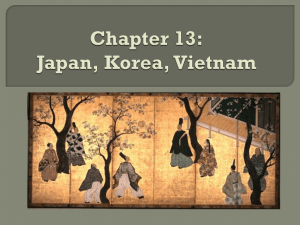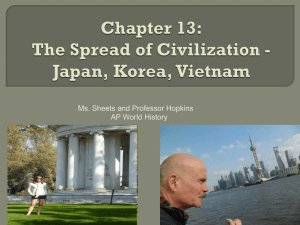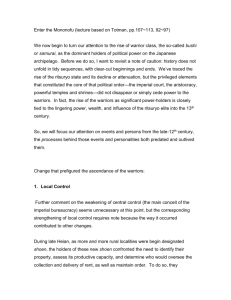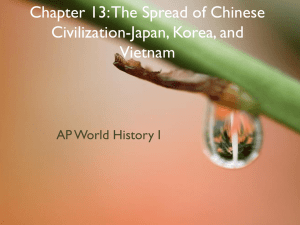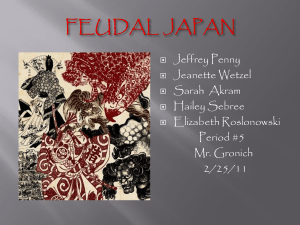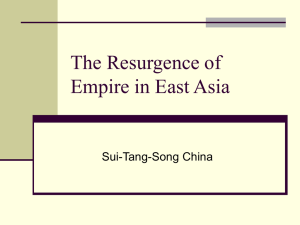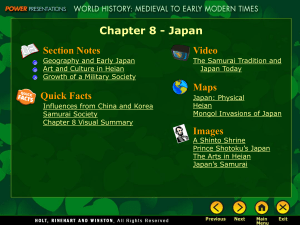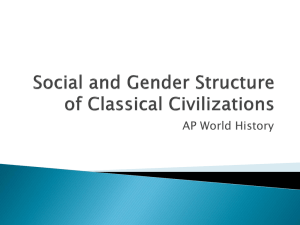Chinese Influence on Japan
advertisement
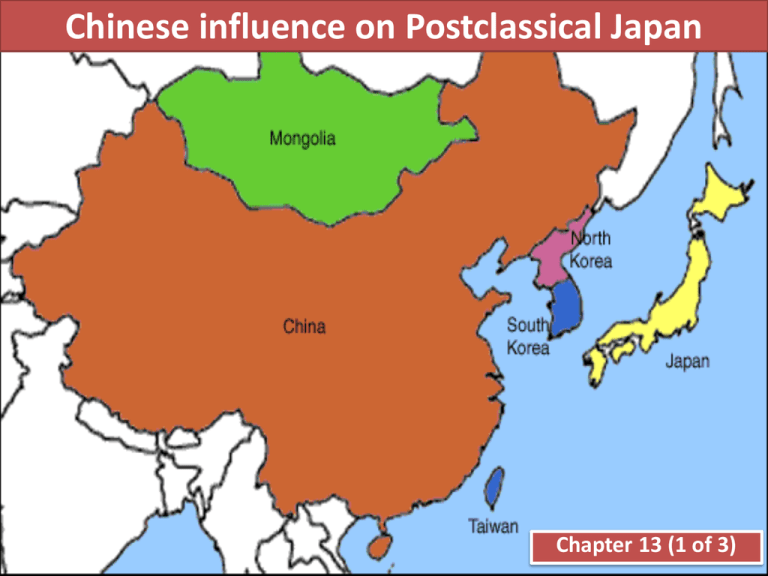
Chinese influence on Postclassical Japan Chapter 13 (1 of 3) Japan Had 3 Major Regimes During Postclassical Era Taika (645 710) Nara Heian (710 784) (794 857) During these regimes, Chinese culture influenced Japan greatly Taika Reforms Created Chinesestyle emperor, bureaucracy, and tried forming a peasant army Taika Reforms = Reforms in 646 to make Japan like China I want to be like him Chinese Influence Takes Hold in Japan (especially amongst the elites) Japan studied Chinese writing and Confucianism, and admired Chinesestyled Buddhist art Peasants affected too – Buddhism spread and temples built Taika Reforms Face Opposition Aristocracy in Japan rejected them b/c created a bureaucrac y that would mean aristocrats would lose power Even peasants grew tired of Chinese influence (ex: the Buddhism they practiced was distinct from Chinese form) Taika Reforms Fail As reforms failed and the imperial government (emperor and his people) lost power Aristocrats living near the capital as well as local lords in the countryside gained power Birth of the Heian Court The emperor and his followers set up a new regime at Heian (the 3rd postclassical regime in Japan we need to know) By 760, the Nara regime (which came after the Taika but supported the Taika reforms) was driven out of the capital of Nara Heian was later renamed Kyoto Heian Emperor Stops the Taika Reforms After setting up new capital at Heian, the emperor ended the unpopular Taika reforms (stopped aristocrats from opposing him) Emperor was upset at Buddhist leaders, who played a big role in opposing Taika reforms, so he banned Buddhist monasteries in Heian Aristocrats Regain Power With Taika reforms a thing of the past, and Chinesestyle rule held off, aristocrats again rose to power in Japan The emperor had never built the peasant army (that was part of the Taika reforms) and he had to rely on provincial lords (lords living in countryside) for military support, meaning emperor was losing even more power Life in Heian (794-857) Even though emperor was losing power, and provincial lords in the countryside were getting stronger, the Heian period saw Japanese culture flourish Society became obsessed with the pursuit of beauty and it was expected that people would be extremely polite to each other Life in Heian (794-857) Imperial family (emperor’s family) and aristocrats lived in palaces with beautiful gardens Buildings in the city were made of unpainted wood with matted floors, and wooden walkways connected the different homes and buildings Poetry Becomes Popular The Japanese simplified the Chinese alphabet they had borrowed, and that led to writing of a lot of poetry and literature Poetry became the major form of art – poems were short but elegant The Tale of Genji = 1st Japanese novel, it was written by Lady Muraski Women in Heian Japan Women wrote poetry, played musical instruments, and even participated in schemes to snub or disgrace a rival Like in China and the Islamic world, women became involved in political power struggles Imperial (Emperor’s) Power Declines Fujiwara = powerful aristocratic family that gained power over the emperor in the 800s As emperor’s power declined, aristocratic families (and even Buddhist monks) began building large estates around Heian, and they controlled the peasants who lived on their land The Country v. The City and the Breakdown of Central Government While aristocrats and Buddhists were gaining power in Heian, in the countryside, local lords built large estates (like kingdoms) and became extremely powerful These provincial lords refused to obey the imperial government and aristocratic families that held power in the capital (ex: stopped giving resources and taxes to central government) Bushi and Their Samurai Bushi was the name given to these local (also called provincial) lords who set up kingdoms in the countryside These bushi hired samurai warriors to fight on their behalf Japan Becomes Chaotic, Violent Mess By the year 1000 C.E., Imperial control broke down in Japan, and bushi and their samurais were constantly fighting Aristocrats in the city (Heian) and even Buddhist monks hired these bushi and their samurais to fight for them, leading to the bushi gaining even more power So, the Japanese Power Struggle c.1000 C.E. Emperor (Imperial Government) and Aristocrats from Heian losing power – this meant centralized government in Japan was breaking down Bushi (lords from the countryside) were gaining power and Japan was becoming a feudal society as these bushi had manor-like estates that were similar to western Europe Samurai Warrior Code Battles were planned ahead of time, and warriors followed a strict code of honor and etiquette Seppuku = defeated warriors required to disembowel (and thus kill) themselves to avoid bringing shame to their families Peasants Lose Out As bushi and their samurais gained power, the peasants became like serfs, bound to the estate of the bushi they lived under Their was a strict class system, and peasants were kept separated from warriors (peasants couldn’t wear same style of clothes as warriors, and not allowed to carry swords or ride horses As peasants lost power, they often turned to pure land Buddhism for salvation Artisan Class Emerges in Japan Artisans were poor and had very little status in society This was unlike China where scholar-gentry often dabbled in artisan work Gempei Wars (1180s C.E.) Fight between 2 powerful aristocratic families for control of Japan (the Taira and the Minamoto) Minamoto had strong alliances with the provincial lords (bushi) which helped them beat the Taira Minamoto in Control After defeating the Taira, the Minamoto established a new capital city at Kamikura The Minamoto set up a military government, known as the bakufu (they kept the emperor as a figurehead, but real power lay with the Minamoto family and their samurais) The military leaders of this new bakufu government were called shoguns Yoritomo = Delusional Yorimoto was leader of Mionamoto family (bakufu government), but had relatives killed b/c he thought they would try to kill him to take throne Because Yorimoto killed so many potential heirs, weak leaders emerged after Yorimoto’s death, and that allowed the bushi (warrior lords in countryside) to gain even more power Hojo Defeats Minamoto The Hojo, a warrior family that had allied and helped the Minamoto, overthrew them and took power Minamoto Not Done Yet Ashikaga Takuaji, a leading Minamoto family member, led revolt and defeated the Hojo, though the Hojo continued to resist for a long time, which weakened Japan Ashikaga established what was called the Ashikaga Shiogunate, which ruled Japan from 1336-1573 Bushi in, Aristocrats in Capital Out For a while, the court The civil war between After Hojo v. Ashikaga aristocracy (that term the Hojo and the Shogunate civil war means the aristocratic Ashikaga Shogunate ended, more civil families who had weakened Japan, and wars erupted, and power in the central the bushi lords were the end result was government in the able to gain so much that the capital city capital city) had been power, the aristocratic was destroyed and losing power as the families in the capital central rule in Japan bushi (provincial were basically wiped was over warriors) were gaining out power So What Happened to Japan? About 300 different kingdoms emerged in Japan, each led by a bushi Bushi became known as daimyos (some differences, but daimyos similar to bushi) This was taking place around the 1400s and into the 1500s One Big Change – The Death of Chivalry Sneak attacks and spying became common, and peasants were armed to help fight (as they did this, they looted and pillaged villages) The chivalric way of the bushi (honor in battle, etc.) was gone, as daimyos didn’t have same etiquette Sneak attacks and spying became common, and peasants were armed to help fight (as they did this, they looted and pillaged villages) Surprisingly, Despite Chaos, Economy Grows and Culture Flourishes Each daimyo built up their estates, so despite Japan being divided into 300 kingdoms, each kingdom was advancing Farming improved as irrigation systems were built and new tools and seeds (such as soybean) were introduced Daimyos even competed to attract merchants to their growing castle towns, and a new merchant class arose (they were important b/c got goods for the military) These merchants even began forming guilds (similar to those in western Europe) Women’s Status Rises Amongst Merchants and Artisans Women had been losing status and power during bakufu period, but during daimyo rule, their status improved Women in merchant and artisan families had most freedom (ex: allowed to run businesses and join guilds) Not All Women Treated Well The bushi had allowed women of the elite class to have some rights and freedoms: could ride horses, and use bow and arrow When daimyos replaced bushi, women’s status fell and they lost rights Daimyos believed in primogeniture (inheritance goes to oldest son), so women lost right to inherit land Daimyos made elite class women kill themselves rather than dishonor family by being raped, and women couldn’t act in theatrical performaces Arts Were Flourishing Zen Buddhism (combined with Shintoism) played big role in the arts flourishing, especially in architecture Beautiful gardens built and tea ceremonies became the rage in Japan Buddhists in Japan were the key and led trade with China Japan Not United, But the Seeds Were Planted Despite constant warfare of the warrior age, economic and cultural development still took place in Japan Though there were about 300 kingdoms across Japan, if these kingdoms could work together, Japan would have a solid base for a unity
